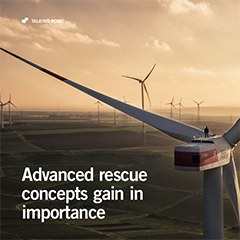When it comes to occupational safety, emergency rescue plans are a critical factor that should not be overlooked. Every company is obliged to create these as part of a risk assessment — including the wind energy industry, which employs tens of thousands of people. For example, if an accident occurs during maintenance or servicing of a wind turbine, basic rescue concepts may not be sufficient. In such cases, personnel with specialist training in rescuing accident victims may be required — individuals who have completed advanced rescue training of the kind that manufacturers of fall protection equipment, such as SKYLOTEC provide. The German company develops and manufactures complete solutions ranging from harnesses to descend devices and rescue stretchers, and also offers a comprehensive training programme worldwide.
Maintenance technicians in the wind energy industry typically work several hundred metres above the ground — and must therefore protect themselves against the dangers of a fall from height. They are required to wear fall protection equipment by law, and for good reason. However, occupational safety is not solely the responsibility of the employees themselves — their companies must also fulfil certain obligations, for example by formulating a carefully planned response in the event of an emergency. Legally speaking, there is no room for manoeuvre here — employers are obliged to develop rescue plans that enable the fastest possible response to any emergency situation.
This is essential because wind turbines are usually to be found in remote locations, making it extremely unlikely that external rescue teams or fire fighters would reach the site in time. Therefore, each company must ensure that accident victims can be rescued by its on-site personnel.
An emergency may occur, for example, if a maintenance technician slips and falls or collapses, due to a medical problem that brings on a dizzy spell or even a heart attack. An injured person left hanging motionless on a rope will usually experience a restriction of their blood circulation. After only a few minutes this can lead to a life-threatening state of shock known as suspension trauma. If this occurs, the victim will lose consciousness and may even die within only a few minutes unless assistance arrives. For this reason, every second counts when it comes to rescuing people under such conditions.
Anyone wanting to work as a maintenance technician on wind turbines in the offshore or onshore industry must therefore also have the necessary knowledge to respond properly in an emergency. For the employees of wind farm operators or companies commissioned to maintain wind turbines, there is simply no room for compromise here. Only personnel who have completed a training course that meets the standards set out by the Global Wind Organisation (GWO) should be permitted to work at height in a wind turbine environment.
These courses are provided by training companies or manufacturers of fall protection equipment — such as SKYLOTEC. The renowned rescue equipment manufacturer conducts training courses worldwide via its Vertical Rescue College (VRC). Furthermore, the training of employees from suppliers or maintenance firms in the renewable energy industry is part of SKYLOTEC’s core business.























